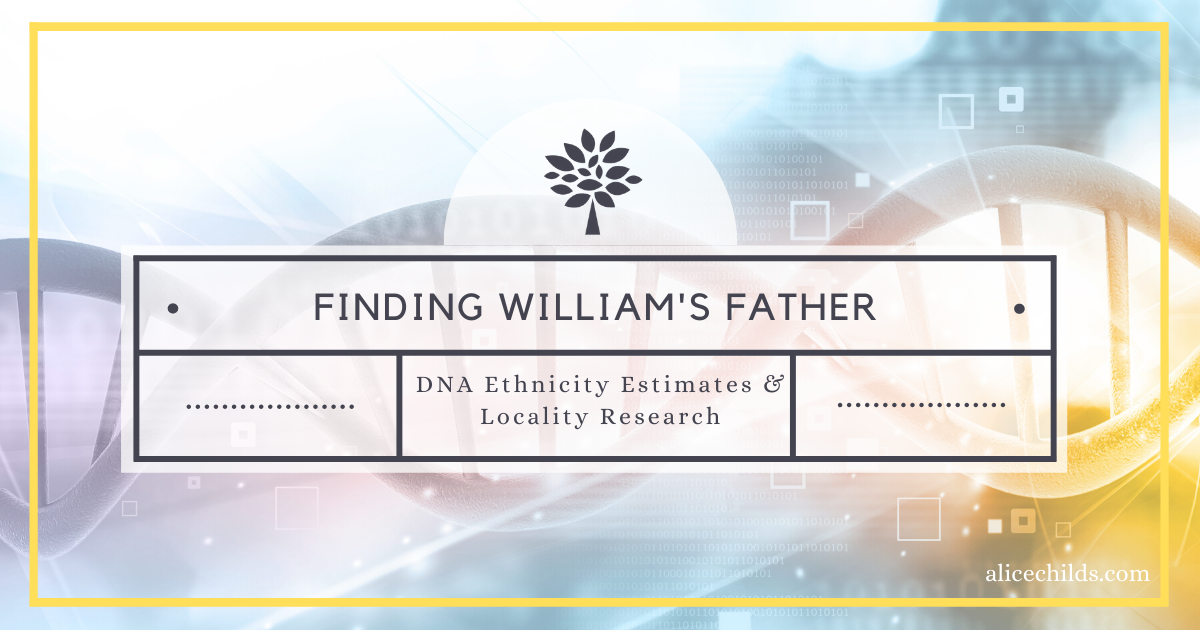
I have been working through the steps to complete a project in which I am trying to discover the name of my 3x great-grandfather using DNA and traditional genealogical research. I’m using my Dad’s DNA reports at Ancestry and MyHeritage for this project. I have written about each step in the process (see links at the end of this post) but here is a brief recap of my progress so far:
*Note: I am following the steps I learned in the Research Like a Pro With DNA study group with Diana Elder, Nicole Dyer, and Robin Wirthlin of Family Locket. Registration for their fall study group begins August 1. I would highly recommend it! I will be participating as a mentor. In the meantime, you can read more about the Research Like a Pro With DNA method here.
I first created my research objective and noted the possible limitations associated with this project.
I then analyzed existing traditional evidence by creating a timeline for William and his mother Ann. I noted that William did not have the surname Stubbs listed on any records prior to the 1880 census. The use of the surname Munford on census records prior to 1870 and on his immigration records, as well as his stepfather’s surname being used on the 1870 census provide evidence that a family story that William chose the surname Stubbs later in life could be true. I was able to obtain William’s birth record from the General Register Office in England. No father was listed, and William’s surname was listed as Munford on this record too.

During my analysis, I also noted Ann’s residences in 1851, 1858 when William was born, and in 1861, along with persons residing in the same household and neighbors on both the 1851 and 1861 England and Wales censuses. This information will play a big part in my research plan.
I analyzed the DNA evidence with an AutoCluster report from MyHeritage along with an AutoCluster report from Genetic Affairs for the Ancestry DNA matches. I identified the Most Recent Common Ancestors for each cluster and determined that the MRCA’s for the Stubbs clusters were William and his wife Isabelle Gavin, along with Ann Munford’s parents Robert and Lydia Munford. No DNA matches in these clusters went back to unknown ancestors in England. As I analyzed each cluster, I began color-coding Ancestry DNA matches using their colored dots. I also identified and messaged possible Y-DNA testing candidates in hopes of discovering a possible surname for William’s father. I haven’t yet heard back from any of the candidates.
I thought I might try to create a network graph using MyHeritage DNA matches, but downloading my match list using the DNA Gedcom Client has proven difficult. I am still trying to figure out how to make it work and I will provide an update if I am successful.
Locality Research
The next step in the Research Like a Pro with DNA process is locality research. I haven’t done much research in England, so it was fun to create a locality guide for Norfolk County and see what resources are available. Thanks to a tip from a colleague, I learned that the National Archives at Kew are allowing free access to all of their digitized collections and allowing up to 50 free downloads from their site while they are closed due to COVID-19. I discovered some collections dealing with maritime records there that may be helpful if the family story that William’s father was a sailor or seaman prove to have some validity.
I also looked a little more closely at the Ethnicity reports at both Ancestry and MyHeritage. It was interesting to see how they differed from one another:

Here is the map provided with Ancestry’s Ethnicity Estimate:

The England, Wales, and Northwestern Europe Region (Yellow) is primarily located in Belgium, Channel Islands, England, and Wales. 68% of my Dad’s ethnicity is from this region.
The Community of East Anglia (Bright Yellow) encompasses the area of Norfolk, where the Munford family lived. This lends validity to the idea that William’s ancestors could come from the Norfolk area in England.
I was interested to note that while there was an additional community in Denmark listed, Denmark wasn’t included as one of the main ethnicities in this report. This interested me because my Dad’s paternal grandfather’s family is from Denmark. However, in small print under the community “Denmark” it does state this community is from the regions of England, Wales, and Northwestern Europe; Germanic Europe; and Sweden. Therefore, Denmark is included in the ethnicity estimate, just not in its own region.
Here is the map MyHeritage supplied with its Ethnicity Estimate:

I am a little confused about why MyHeritage would report 0% English ethnicity. The Irish Scottish, and Welsh ethnicity does include portions of England, but it is definitely not centered there and does not include the region of Norfolk at all. I am aware that the way ethnicity estimates are generated varies from company to company, so this could explain some of the differences between the two.
The Scandinavian ethnicity description from MyHeritage states that it includes Sweden, Norway, and Denmark, which makes sense given our Danish ancestry.
Next Step: Creating a Research Plan
Now that I have analyzed existing sources and examined the locality for this project, I am ready to create a research plan. I will be including both traditional and DNA research in my plan, which I will be sharing next week.
If you missed the first few posts in this series, you can get caught up by reading them here:
Finding William’s Father: Using DNA and Traditional Research to Solve a Family History Mystery
Finding William’s Father: Timeline Analysis in a DNA Project
